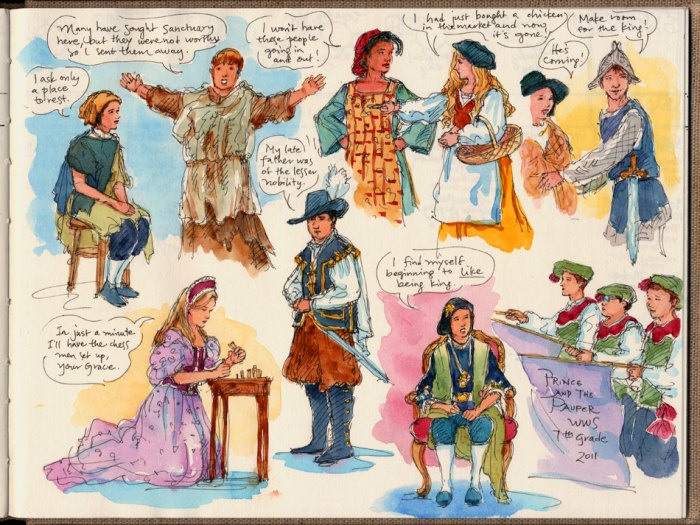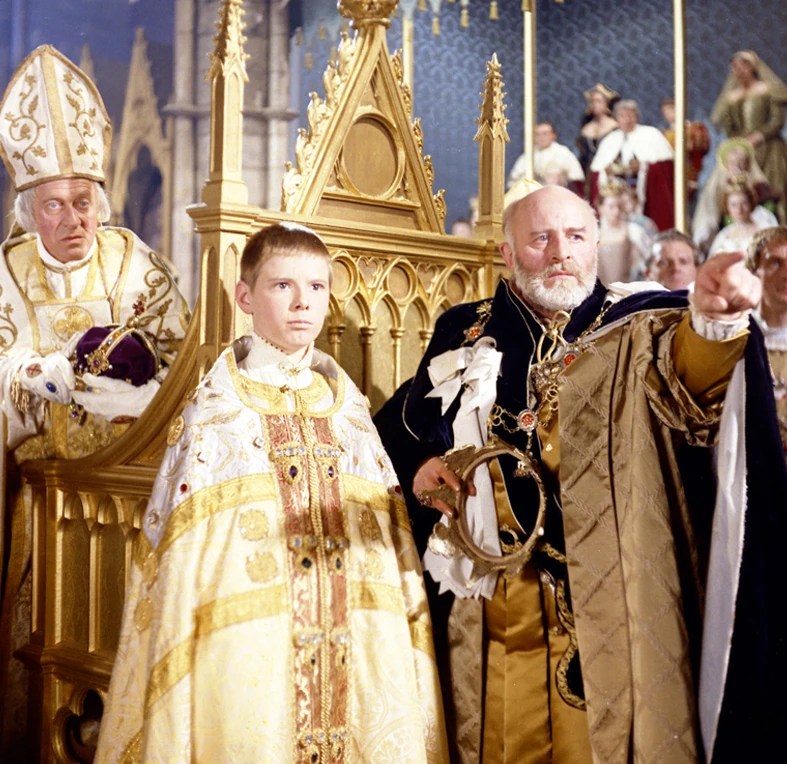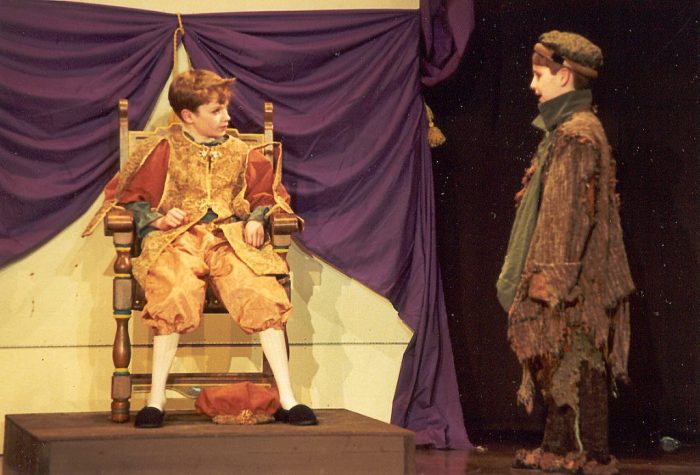The Prince and the Pauper characters embody the stark contrast between wealth and poverty in Tudor England, highlighting the injustices and hardships faced by the underprivileged. This captivating novel explores the themes of equality, compassion, and social justice through the mistaken identities of Prince Edward and Tom Canty, challenging their preconceived notions of themselves and others.
Main Characters

Mark Twain’s novel, “The Prince and the Pauper,” introduces a cast of compelling characters who embark on extraordinary journeys of self-discovery and societal transformation. At the heart of the story lie two contrasting figures: Prince Edward, the heir to the English throne, and Tom Canty, a poor street urchin.
Their contrasting backgrounds and personalities shape the narrative, as they navigate the complexities of their respective worlds and grapple with the challenges that come their way. The relationships between the main characters, particularly the bond that develops between Edward and Tom, form the emotional core of the novel, highlighting themes of empathy, identity, and the nature of true nobility.
Prince Edward
Prince Edward is the young and idealistic heir to the English throne. Raised in a life of privilege and sheltered from the harsh realities of the world, he is characterized by his compassionate nature, intelligence, and a strong sense of justice.
Despite his royal status, Edward possesses a genuine concern for the well-being of his people, a trait that sets him apart from the corrupt and self-serving court.
- Edward’s journey of self-discovery begins when he encounters Tom Canty, a street urchin who bears a striking resemblance to him. The encounter forces Edward to confront the inequalities that exist within his kingdom and challenges his preconceived notions of society.
- Through his experiences as a pauper, Edward gains a firsthand understanding of the hardships faced by the common people. This transformative experience shapes his character, fostering a deep sense of empathy and a commitment to using his power to improve the lives of others.
Tom Canty
Tom Canty is a resourceful and quick-witted street urchin who lives in the impoverished streets of London. Despite his humble origins, Tom possesses a sharp mind, a kind heart, and an unwavering determination to survive. His encounter with Prince Edward thrusts him into a world he could never have imagined, forcing him to adapt and navigate the complexities of court life.
- Tom’s journey is one of resilience and self-discovery. As he assumes the role of the prince, he learns the importance of responsibility, leadership, and the power of compassion. Despite the challenges he faces, Tom never loses sight of his true identity and the values that have shaped him.
- Through Tom’s experiences, Twain explores the idea that true nobility lies not in one’s birthright but in one’s character and actions. Tom’s unwavering spirit and his ability to connect with people from all walks of life ultimately earn him the respect and admiration of those around him.
Relationships
The relationships between the main characters in “The Prince and the Pauper” are central to the novel’s themes and plot development.
- Edward and Tom:The bond between Edward and Tom is the heart of the novel. Despite their vastly different backgrounds, they develop a deep friendship based on mutual respect, understanding, and a shared desire to make the world a better place.
- Edward and Miles Hendon:Miles Hendon is a loyal and courageous knight who befriends Edward during his time as a pauper. Hendon’s unwavering support and guidance help Edward navigate the challenges he faces and ultimately reclaim his throne.
- Tom and Lady Jane Grey:Lady Jane Grey is a young and intelligent woman who becomes Tom’s tutor while he is posing as the prince. Jane’s kindness and wisdom help Tom adapt to his new role and inspire him to embrace his own potential.
Social Class and Poverty
In 16th-century England, society was rigidly stratified, with a vast gulf separating the wealthy elite from the impoverished masses. The novel vividly depicts this stark contrast, highlighting the injustices and hardships faced by the underprivileged.
The Opulence of the Wealthy
- The wealthy elite, including Prince Edward, lived in opulent palaces adorned with luxurious furnishings and tapestries.
- They enjoyed lavish feasts, attended balls, and had access to the finest education and healthcare.
- Their lives were characterized by privilege, comfort, and excess.
The Plight of the Poor
- The poor, represented by Tom Canty, lived in squalid slums, often sharing overcrowded and unsanitary dwellings.
- They struggled to find food, clothing, and shelter, and many resorted to begging or crime to survive.
- Disease and malnutrition were rampant, and life expectancy was significantly lower for the poor.
The Role of Social Class
Social class played a pivotal role in shaping the characters’ experiences and interactions.
- Edward, as a prince, was revered and obeyed by all, while Tom, as a pauper, was treated with contempt and indifference.
- The novel demonstrates how social class influences opportunities, relationships, and the overall trajectory of one’s life.
- It challenges the notion of meritocracy, revealing that even in a society supposedly based on individual worth, privilege and poverty can create insurmountable barriers.
Identity and Deception: The Prince And The Pauper Characters

The mistaken identities in The Prince and the Pauperare pivotal to the novel’s plot and character development. The switch between the prince and the pauper forces them to confront their preconceived notions of themselves and others, and to grapple with the ethical implications of their deceptions.
Challenging Preconceptions
As the prince assumes the role of the pauper, he gains a firsthand experience of the hardships and injustices faced by the poor. This challenges his assumptions about his own superiority and the natural order of society. Similarly, the pauper, now posing as the prince, is confronted with the responsibilities and expectations that come with power.
This forces him to question his own worthiness and the true nature of authority.
Ethical Implications
The characters’ deceptions raise important ethical questions about the boundaries of identity and the limits of deception. The prince’s decision to keep his true identity a secret from the pauper could be seen as a betrayal of trust. However, it could also be argued that he is justified in doing so in order to protect the kingdom from chaos and instability.
Historical Context

Mark Twain’s The Prince and the Pauperis set in Tudor England during the reign of King Henry VIII. This period was a time of great social and political upheaval, as the country transitioned from a medieval society to a more modern one. The novel reflects these changes by portraying the stark contrast between the lives of the rich and the poor, and by highlighting the importance of social class and identity.
Tudor England
Tudor England was a time of great change and upheaval. The country was transitioning from a medieval society to a more modern one, and this led to a number of social and political changes. One of the most significant changes was the rise of the middle class.
The middle class was made up of merchants, traders, and other professionals who were not part of the aristocracy or the peasantry. The rise of the middle class led to a decline in the power of the aristocracy, and it also led to a number of new social and cultural changes.
Themes and Symbolism
Mark Twain’s “The Prince and the Pauper” explores profound themes that resonate with readers of all ages. The novel delves into issues of equality, compassion, and social justice, challenging societal norms and fostering a deeper understanding of human nature.
Twain employs powerful symbolism and imagery to convey these themes. The exchange of clothes between the prince and the pauper symbolizes the fluidity of social status and the arbitrary nature of class distinctions. The contrast between the opulent palace and the squalid streets of London highlights the stark inequalities that divide society.
Equality
- The novel argues that all individuals are inherently equal in worth and dignity, regardless of their social status or material possessions.
- Through the experiences of the prince and the pauper, Twain demonstrates that compassion and empathy transcend social boundaries.
Compassion, The prince and the pauper characters
- The novel emphasizes the importance of compassion and empathy in fostering a just and equitable society.
- The transformation of the prince and the pauper’s characters illustrates how compassion can break down barriers and lead to personal growth.
Social Justice
- The novel critiques the injustices and inequalities inherent in the rigid class system of 16th-century England.
- Twain argues that social justice requires challenging oppressive structures and creating a society where all individuals have equal opportunities.
Enduring Relevance
The themes explored in “The Prince and the Pauper” remain relevant today, as societies continue to grapple with issues of inequality, poverty, and social injustice.
The novel’s enduring impact lies in its ability to inspire readers to reflect on their own values and to work towards creating a more just and compassionate world.
Helpful Answers
Who are the main characters in The Prince and the Pauper?
The main characters are Prince Edward, the heir to the English throne, and Tom Canty, a poor street urchin.
What is the significance of the characters’ mistaken identities?
The mistaken identities allow the characters to experience life from a different perspective, challenging their preconceived notions of themselves and others.
What are the major themes explored in The Prince and the Pauper?
The major themes include equality, compassion, social justice, and the importance of empathy.